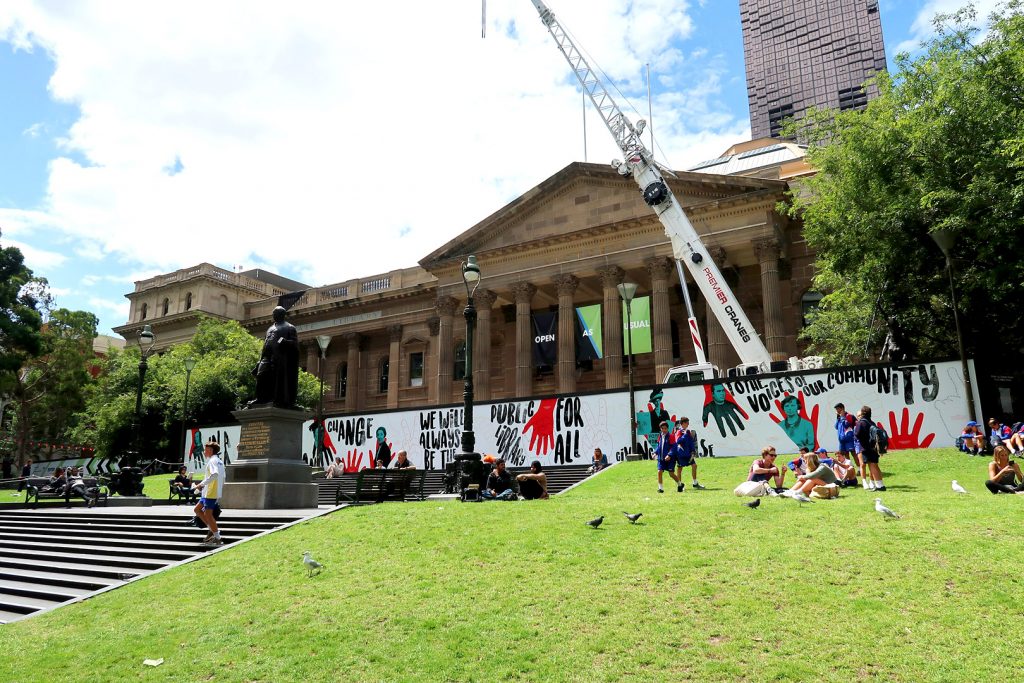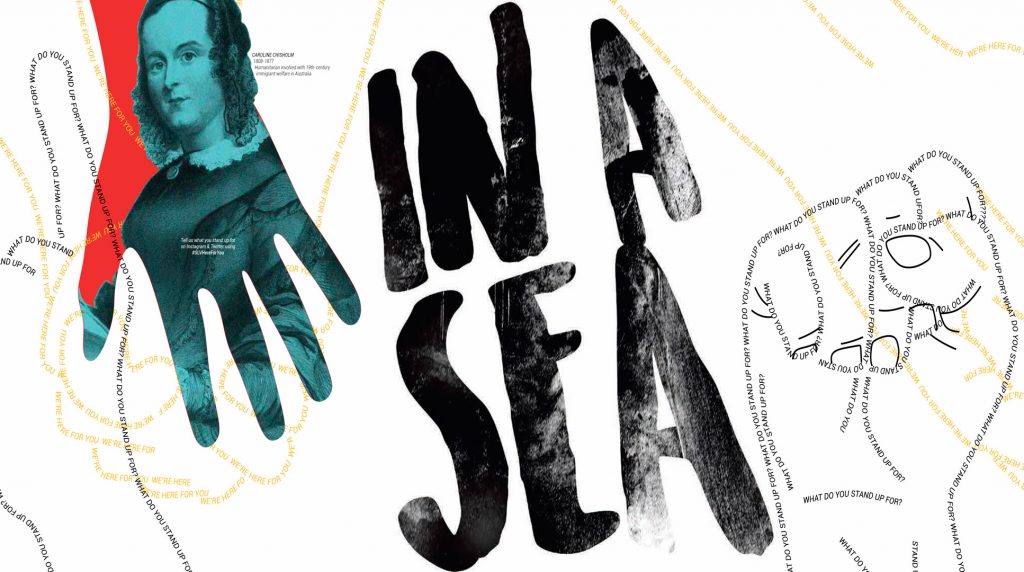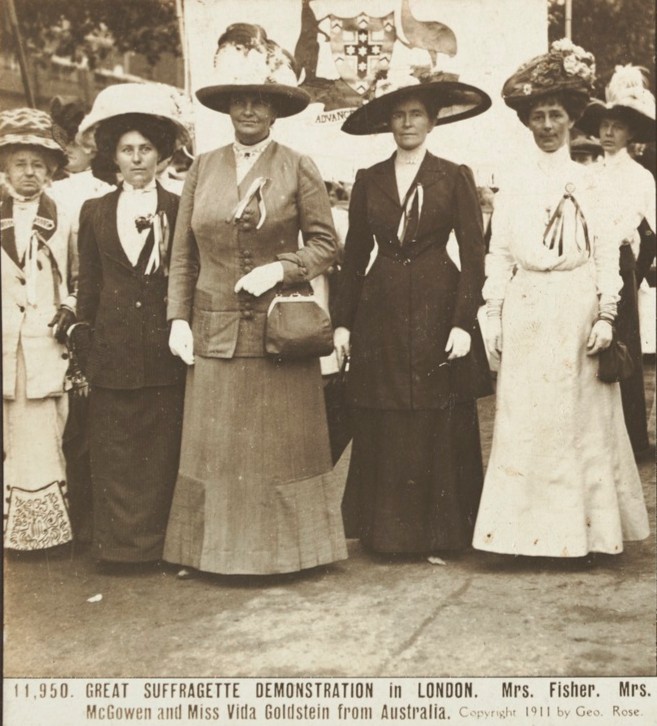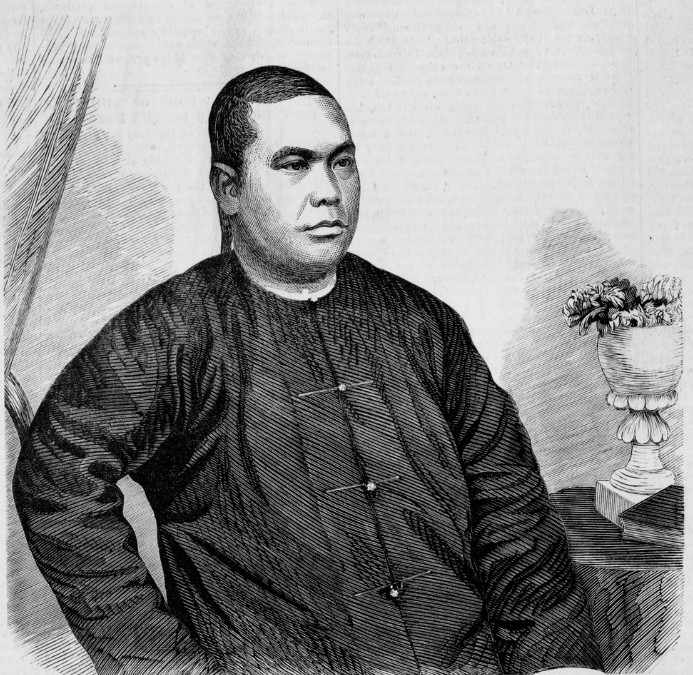The artwork now decorating the front of the Library is Here for you by Vivian Lim. This original artwork is part of a joint initiative with RMIT University, displaying works that reflect our Library’s transformation, and draw inspiration from our history and collections.

Stretching across our Swanston Street aspect, the work is, from a distance, as imposing and beautiful as the building it frames, and, as with the Library, closer inspection reveals depth and insight.
The artist gives a vivid statement on the enduring importance of our Library to the community of Victoria:
The State Library’s philosophy has always been to provide a place universally accessible for all. The Library forecourt has been the backdrop for 163 years of social change as a place of gathering to protest or to connect in harmony, and – even today – a place that belongs to the public.
Vivian Lim, Here for you, artist statement

The work features portraits of influential people who have stood up for their beliefs and driven change in Victoria and Australia. Vivian has used this 27-metre-long canvas as a rallying cry, asking the viewer: “What do you stand up for?”

Click to zoom in on this section of Here for you by Vivian Lim.
The figures depicted are:
Caroline Chisholm (1808–1877) was a notable humanitarian and social reformer in the early days of the Australian colonial settlement. Working tirelessly in Sydney for the welfare of vulnerable, single immigrant women and girls, she sailed to England in 1846 to lobby extensively for improved conditions and opportunities for emigrants to Australia, focussing now more on family emigration. She gave evidence to a number of parliamentary committees who noted that “her zeal and exertions in the cause of the poor emigrant, entitles her to high respect” [1]

She received support across Britain, notably from Charles Dickens through the pages of his magazine Household Words [2] On her return to Australia she took her work to Melbourne and the Victorian goldfields.

Margaret (Lilardia) Tucker (1904–1996) was a dedicated and inspiring activist for Indigenous rights and recognition. Margaret was forcibly separated from her family at age 12 and sent to the Cootamundra Domestic Training Home for Aboriginal Girls. She was then placed in various white households as a domestic servant. In 1932, she co-founded the Australian Aborigines League and continued to campaign for the rest of her life. She was awarded the Member of the Most Excellent Order of the British Empire in 1968 in honour of her activism. When launching her autobiography Kim Beazley remarked that Margaret had “the spirit that refuses to hate when people are hateful.”[3]
Sir Redmond Barry (1813–1880) was a great supporter of education and reading. In fact he made his own Bourke Street home an informal library, inviting strangers to borrow from his personal book collection. Little wonder then that he was the driving force behind the establishment of both Melbourne University, and our great Library.

In the establishment of the Library he realised his vision for a vast emporium of knowledge; free, secular and democratic. He was a lawyer by profession and often appeared for Indigenous Australians brought before the courts. He was an initial judge of the Victorian Supreme Court (established after Victoria separated from NSW). It was he who presided over the acquittal of the Eureka rebels and, more famously, passed sentence on Ned Kelly.
Ethel Florence Lindesay (Henry Handel) Richardson (1870–1946) was one of the great novelists of the early 20th century. Such was the lack of opportunity for women to be considered serious authors, she used a male pseudonym.
This clearly confused some reviewers, particularly when considering her autobiographical novel The getting of wisdom. The British journal Votes for Women found that:
Not many writers can tell the inner history of a schoolgirl’s development in so absorbingly interesting way as Mr Henry Handel Richardson has done … and it is not unnatural to want to know also who is the unnamed little collaborator who helped the author to get inside that region difficult to explore – a schoolgirl’s heart. [4]

Vida Goldstein (1869–1949) was a pioneer campaigner of the women’s suffrage movement in Victoria, a leader of the Women’s Peace Army and fierce anti-conscriptionist during World War I. Remarkably, she was a contemporary of Ethel Richardson at Presbyterian Ladies College, Melbourne.

Lowe Kong Meng (1831–1888) was a merchant and Chinese community leader in Melbourne. Many Chinese came to Victoria during the gold rush and with great industry they carved out lives in an alien culture. They were subject to much discrimination. This was institutionalised through various punitive legislative acts. [5]
Born in Penang and fluent in several languages, including English, Lowe Kong Meng was already an experienced and successful businessman in Asia when the lure of the gold rush brought him to Victoria. He owned a fleet of ships and engaged in extensive commercial pursuits. He also became a leader of the Chinese community and a respected member of Melbourne society.
He was appointed commissioner for the Melbourne Exhibitions of 1880 and 1888. Such was his standing that the Chinese Emperor conferred on him the title of mandarin of the blue button in 1863.

A contemporary news reports noted:
Kong Meng is much respected, not only in his capacity as a merchant, but for his personal qualities … His acts of benevolence are not restricted to any class
Most of the philanthropic institutions of the country have his name upon the list of their most munificent patrons, and his gifts to private charities are liberal in the extreme. Fortunately, his success in trade enables him to indulge his generosity which, although great, is never accompanied by ostentation — without injury to himself. It is almost unnecessary to state that he is immensely popular with the “Chinese residents”.[6]
Isabella Fraser (1881–1969) was our first female staff member. Isabella has been recognised in the Library’s redevelopment with the new Isabella Fraser room named for her.
Isabella started working at the Library in 1908. She was first appointed as an Assistant in 1924. She was probably undertaking librarian or library technician duties in her role as Assistant, but was not a librarian by title. By 1931 she held a Bachelor of Arts qualification.
Women were not allowed to become full librarians in Victoria until 1926 when the Women’s Qualification Act 1926 was passed. [7]

Here for you,Vivian Lim (detail)
Remember that during the current phase of the Vision 2020 redevelopment, the Library entrance is via Russell Street or La Trobe Street. However, as you pass along Swanston Street come up the steps and share some time with Vivian’s wonderful artwork, and the people and ideas highlighted within it.
More to explore
The history of State Library Victoria research guide
References
[1] Select Committee on Emigrant Ships second report p. vii House of Commons (Great Britain)
[2] For example see Household Words Vol 1 1850 p19–24. Dickens was an admirer of Caroline’s work, but he did not let that stand in the way of his art, using her, rather uncharitably, as inspiration for Mrs Jellyby in Bleak house see Collins, P A W “Bleak house and Dickens’s household narrative.” Nineteenth-century fiction, vol 14, no 4, 1960, pp 345–349.
[3] A woman who refuses to hate The Canberra Times August 24, 1977 p. 11. See also If everyone cared: autobiography of Margaret Tucker M.B.E.
[4] Votes For Women (London) November 11, 1910 p.86
[5] See for example An Act to regulate the residence of the Chinese Population in Victoria (1857)
[6] The Chinese in Victoria The Herald August 17, 1863 p. 4. See also The Chinese question in Australia, 1878-79 edited by L. Kong Meng, Cheok Hong Cheong, Louis Ah Mouy.
[7] Girl librarians The Herald December 11, 1926 p. 20


Informative and inspiring post Andrew! And equally Vivian’s artwork.